It seems like every year there’s a new Chromebook that really moves the category forward. Google’s Pixelbook, Samsung’s Galaxy Chromebook, Lenovo’s Chromebook Duet and Acer’s Chromebook Spin 713 all come to mind. The HP Elite Dragonfly Chromebook is now on that list. HP, Google and Intel set out to create a complete Chromebook for enterprise more than two years ago and the Elite Dragonfly Chromebook is the result, a legit ChromeOS dream machine for hybrid workers.
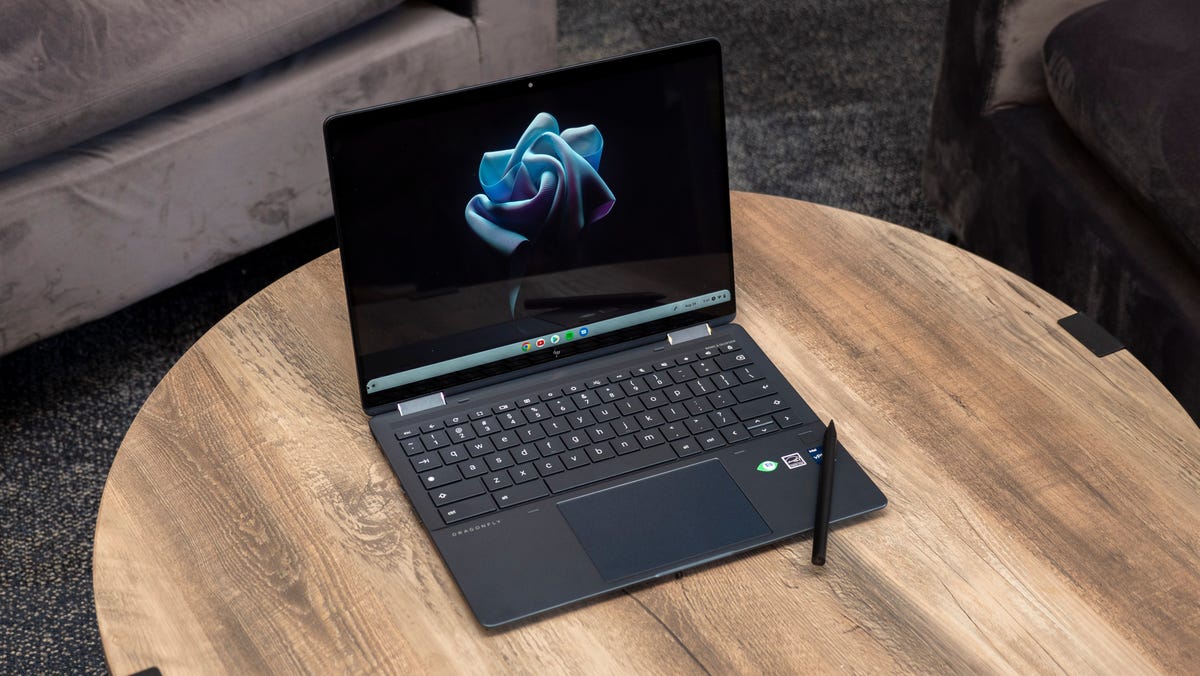
Josh Goldman/CNET
But despite the Elite Dragonfly Chromebook’s greatness, it’s probably not for you. Again, this is primarily designed for businesses. Of course, for consumer Chromebook converts who already know the right combo of web, Android and Linux apps needed to get their work done, the Elite Dragonfly is perfect for being productive anywhere.
Unless your IT department is handing one of these beauties over to you, though, the price is likely going to be a deterrent. The Elite Dragonfly Chromebook starts at $1,149. The custom configuration HP sent us for review is more than $1,500, however, and it’s an enterprise model with an Intel Core i5 vPro processor — a first for Chromebooks — to increase security (which is already strong on Chromebooks). Enterprise versions also get a year of Parallels for Chromebook for those who might need legacy software. For commercial use, you might want a vPro chip but otherwise, the base model is going to be plenty for most Chromebook users. It doesn’t include HP’s excellent wireless rechargeable pen and it also doesn’t support the pen available for HP’s Chromebook x2 11.
Like
- Great look and feel
- Fantastic video conferencing experience
- Thunderbolt 4
- 4G LTE/5G wireless available
- Haptic touchpad and spill-resistant keyboard
- Extra security with vPro
Don’t Like
- USI pen not included with all configurations
- Palm rejection could be better
- Made for business and priced that way
HP Elite Dragonfly Chromebook
| Price as reviewed | $1,519 |
|---|---|
| Display size/resolution | 13.5-inch 2,256×1,504 touch display |
| CPU | Intel Core i5-1245U vPro |
| Memory | 8GB LPDDR4X 4,266 MHz |
| Storage | 256GB NVMe PCIe SSD |
| Connections | Thunderbolt 4 USB-C (x2), USB-A, HDMI 2.0 out, microSD slot, 3.5mm combo audio jack |
| Networking | Wi-Fi 6E (802.11ax), Bluetooth 5.2, 4G LTE/5G optional |
| Operating system | ChromeOS/Android 11 |
| AUE | June 2030 |
Complete collaborative experience
One of the main things HP, Google and Intel focused on with the Elite Dragonfly Chromebook was the collaborative experience. Most manufacturers in the past year bumped up the webcam resolution on premium Chromebooks from 720p to 1080p aka HD to full HD. HP did that, putting a 5-megapixel webcam in the Dragonfly. But it also uses image processing developed originally for Google Pixel phone cameras. There is HDR processing going on in the background to balance out strong shadows as well as blown-out highlights.

Thanks to HDR algorithms from Pixel phones, the Dragonfly’s webcam delivers great results with backlit subjects.
Josh Goldman/CNET
For example, the picture above is a screenshot of the Dragonfly’s webcam. I’m sitting in a room only lit by the window behind me. While the image is slightly soft and noisy because of the low-light conditions of the room, it’s by no means bad. More importantly, the color is accurate and I’m not shrouded in shadows and the building outside the window is visible, not entirely blown out by sunlight. Try this with just about any other built-in webcam and you’d never get an image like this.
And while many laptops will kick on their fans a few seconds into a conference call, the Elite Dragonfly stays silent because of how optimized it is for the task. Add in strong noise cancellation for the built-in mics and clear, clean audio from its top-firing speakers and video calls are actually pleasurable. Plus, there’s a physical privacy shutter on the camera and a mic mute button on the keyboard for when you don’t want to be seen or heard.
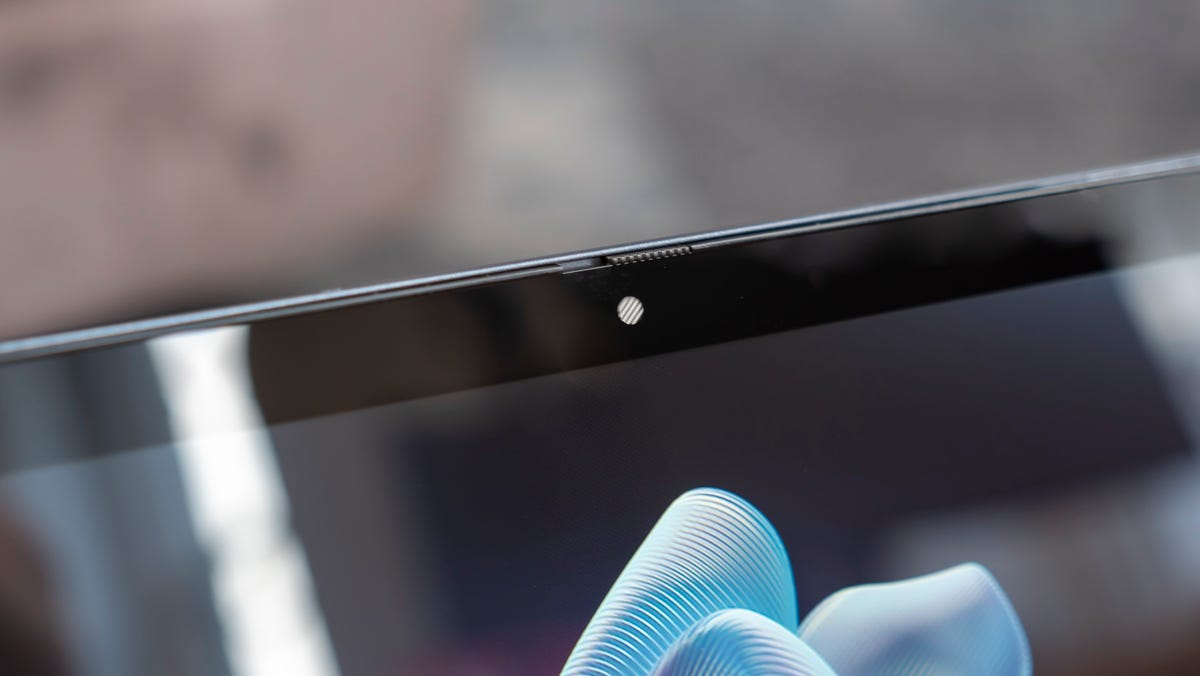
A built-in shutter lets you quickly block the webcam.
Josh Goldman/CNET
Performance to get you through the day
The 12th-gen Intel Core i5 processor is a champ, getting me through typical workdays using a mix of Chrome and progressive web apps for Microsoft Office and Zoom, Adobe Creative Cloud apps from the Play store and the Linux app for Slack. As I mentioned earlier that this is the first VPro Chromebook, but it’s an Intel Evo laptop, too. The two combined mean the Dragonfly meets certain standards for design and performance.
Evo is essentially a guarantee the Chromebook has a thin-and-light body (it weighs less than 3 pounds), has all-day battery life (10 hours, 56 minutes on our streaming video test), instant-on performance when you lift the lid and fast wireless. With VPro it adds enhanced security, namely total memory encryption (TME) and KeyLocker. HP also included a fingerprint reader on the keyboard deck for additional security, though I would rather have it integrated into the power button on the left side of the body for when the two-in-one is in tablet or stand mode.
Haptic touchpad, spill-resistant keyboard, tall display
HP started talking with Google more than four years ago about adding a haptic touchpad to Chromebooks. Coincidentally, the talks dovetailed with Google’s desire to improve the keyboard and trackpad experience overall for Chromebook users. The basic idea: create a premium device with a touchpad so good you won’t need to carry around a travel mouse.
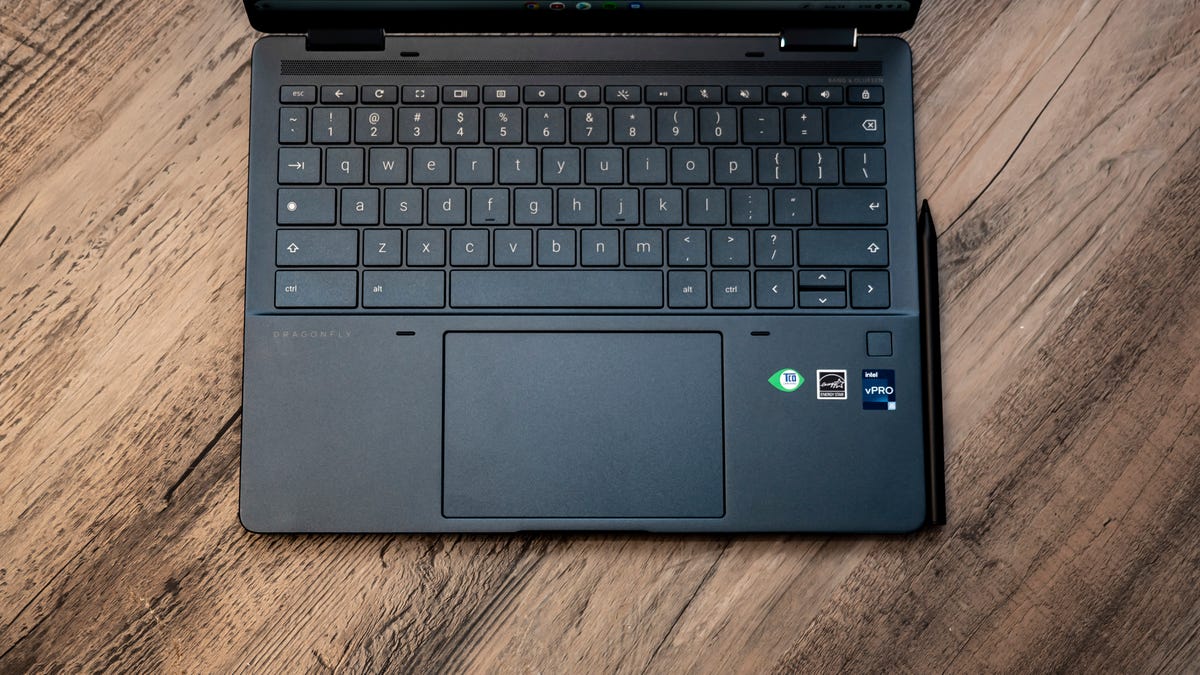
The keyboard is comfortable and the haptic touchpad is big and responsive.
Josh Goldman/CNET
The Elite Dragonfly’s haptic touchpad (another first for Chromebooks) feels like a traditional click and not like a vibration you’d get from a phone or tablet display. Plus you get the same click feel regardless of where you press on the pad. The strength is adjustable but even maxed out it’s not aggressive. I do wish there was some way to increase palm rejection, though, because I regularly ended up dragging the cursor on the screen while typing.
The haptics work for other ChromeOS actions, giving you a little buzz when you switch between virtual desktops, for example, or when you snap a window to one side of the display. Google also has plans to build out haptic integration into other areas such as Google Workspace apps. Having this touchpad makes the Elite Dragonfly Chromebook that much more attractive for work.
There’s not much to say about the backlit keyboard beyond that it’s spacious and comfortable to type on for an extended time. I also appreciate that HP made the function keys a little smaller to squeeze in buttons for the keyboard backlight, playing/pausing media and muting the mic.

The stylus tools menu shows you the battery life for the Elite Dragonfly’s USI pen.
Josh Goldman/CNET
As I mentioned earlier, my Dragonfly included an excellent USI pen for taking notes or drawing on the display. It wirelessly charges on the right side of the Chromebook. It magnetically snaps to the side and starts charging and it attaches strongly enough to store that way.
The 3:2 display is close to the size of a standard sheet of paper, making it nice for note-taking. It’s also tall so you can fit more vertically on the screen for less scrolling while you work. It wasn’t quite bright enough to use outdoors without fighting reflections but it was manageable. HP does offer a 1,000-nit panel which would be the way to go for frequently working outdoors. Plus, it features HP’s privacy screen to block people from seeing what’s on the display from an off angle.
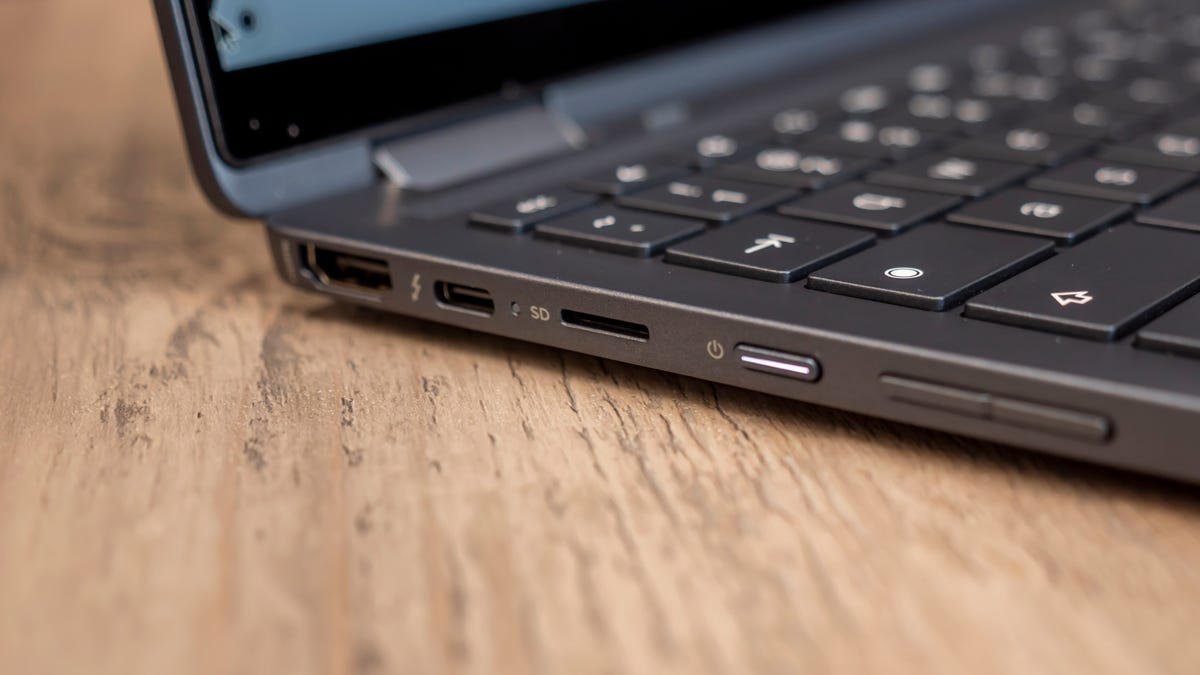
The Dragonfly Chromebook can be directly connected to an external display by HDMI or USB-C.
Josh Goldman/CNET
While the display, keyboard and touchpad are excellent, sometimes it’s just more comfortable to work on a big display and use a full-size keyboard and mouse. The Elite Dragonfly Chromebook has a Thunderbolt 4 port on each side. That means you can not only charge from either side but connect to a docking station like the HP Elite Thunderbolt Dock G4 for a single cable connection to all your peripherals for quickly getting to work.
The dock adds an Ethernet port for the Dragonfly for a wired web connection while working at a desk. But the Chromebook has top-flight wireless, too, with Wi-Fi 6E as well as optional 4G LTE and even 5G support (yet another first for a Chromebook).
A Chromebook crystal ball
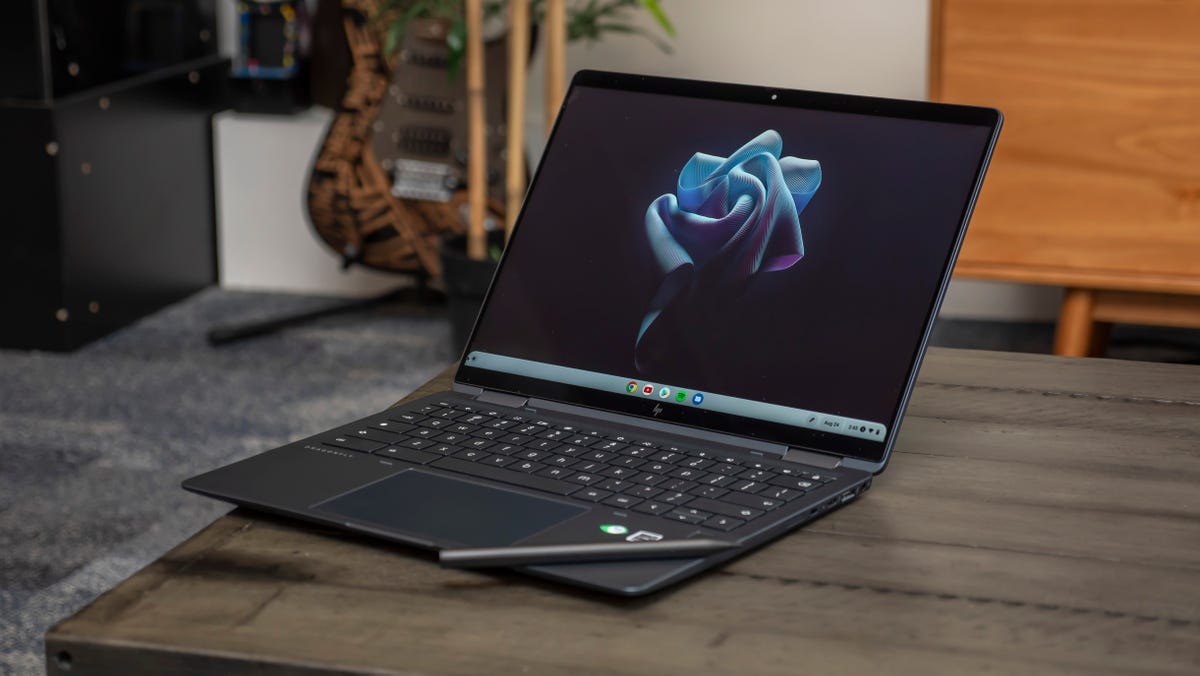
Josh Goldman/CNET
Chromebooks were somewhat indistinguishable for several years after they first arrived in 2011. But as ChromeOS matured, higher-end Chromebooks started to show up more regularly. Although, even these premium models topped out at around $500, except for the occasional showpiece. The HP Elite Dragonfly Chromebook is a showpiece, loaded with several design and technology pieces that will find their way into future Chromebooks for both business and personal use. It carries a hefty price tag that is likely too much for most people considering a Chromebook, even a premium model. But it’s also worth every penny.
Still, if it’s too much, the next best options right now are the Acer Chromebook Spin 714 or the slightly less expensive Spin 513. You can also check out our list of top Chromebooks that we’ve tested.
The review process for laptops, desktops, tablets and other computer-like devices consists of two parts: performance testing under controlled conditions in the CNET Labs and extensive hands-on use by our expert reviewers. This includes evaluating a device’s aesthetics, ergonomics and features. A final review verdict is a combination of both those objective and subjective judgments.
The list of benchmarking software we use changes over time as the devices we test evolve. The most important core tests we’re currently running on every compatible computer include: Primate Labs Geekbench 5, Cinebench R23, PCMark 10 and 3DMark Fire Strike Ultra.
A more detailed description of each benchmark and how we use it can be found in our How We Test Computers page.




